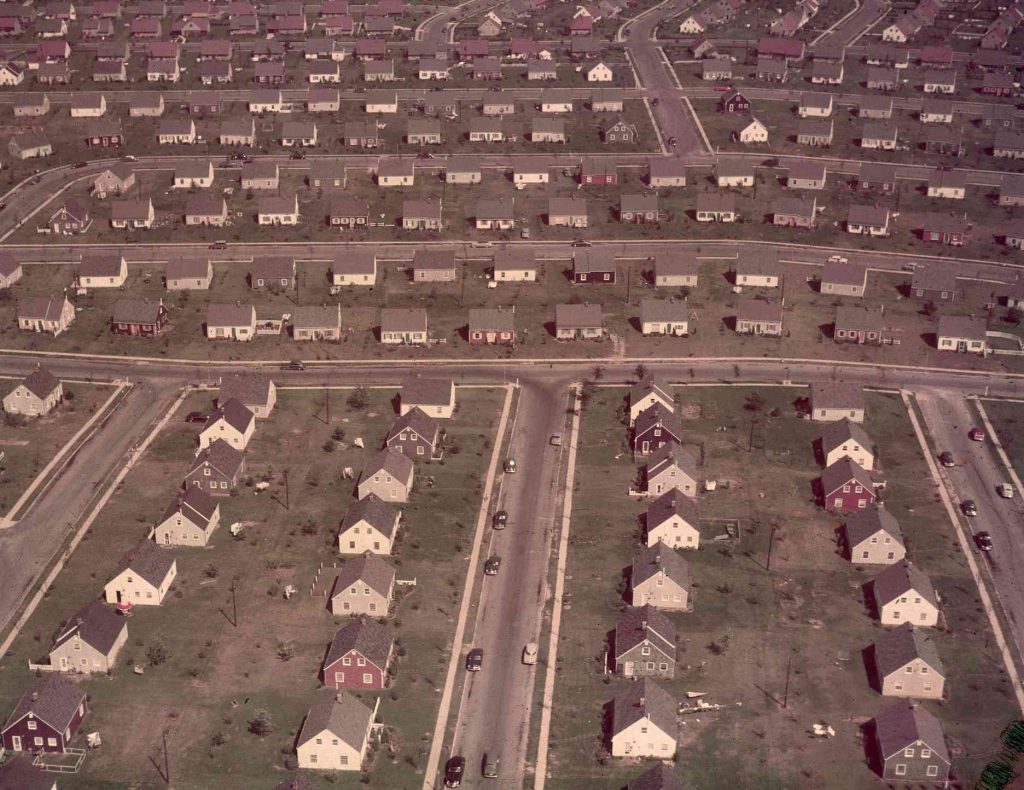A favored housing type of the 1950s was one that originated in Colonial New England. Developers seized on the historic Cape Cod house style and promoted it as an all-American ideal. Within a decade, these compact, efficient homes could be found in nearly every part of the country.
Of course, the Cape Cod homes of the 1950s were not replicas of historic Cape Cods. Builders borrowed features of the Colonial style and added mid-twentieth century modernizations. In this gallery, you’ll find a sampling of 1950s-era Cape Cods sold in communities across North America. Each plan offers a different version of the Colonial idea.
-
01
of 05Cranberry Cape Cod House Plan
The name of this house plan, “Cranberry,” describes the intent of the designers—the cranberry is found throughout the Cape Cod area of Massachusetts. The house plan’s living area, or floor space, is 1,064 square feet.
Why Is This a Cape Cod Design?
- Rectangular shape, with added porch
- Center chimney, similar to the “Hearth” plan
- Front door placed at the center
- Steep pitch to the roof
- Side gables
- Shutters
- Eight-over-eight multi-paned, double-hung windows
- Center-hall floor plan
One-And-A-Half Stories
Some would call this a two-story house, because of the second-floor bedroom area. However, the designers call this a “one-and-a-half story home.” Why? When second-floor interior rooms are box-like, an attic creates the square shape. When second-floor ceilings take the sloped shape of the roof, the story is often considered “half.” The slant of the roof becomes part of the upstairs ceilings. The ceiling height for both the first and second floors is 7 1/2 feet. On the second floor, this height must be at the roof peak, which is the highest point of a very steeply pitched roof.
An Unseen Rear Dormer?
Notice the upstairs storage in the home’s front, spatially equivalent to the closets and bathroom in the back. The upstairs rear windows, which provide “cross ventilation,” would have to be small, narrow basement-type windows through the sloping roof, unless dormers were part of the design. Dormers are often built to create additional space and are sometimes added after a small house is built. This plan, however, may have an unseen rear dormer to accommodate the rear windows—not to mention for the comfort of guests to the second floor rear bathroom. Other house plans in this series, such as “Jewel,” show a rear dormer more clearly on the floor plan, although not in its illustration.
Marketing This House Plan
The interior sketches of the kitchen, utility, and dining areas seem to have no basis in reality when compared with the floor plans. What is called the “Acme of Convenience” and inviting areas of “Work-Saving Informality” appear to be pure marketing.
-
02
of 05Hearth Cape Cod House Plan
The name of this house plan, “Hearth,” describes what is being sold—warmth, family, and tradition.
Why Is This a Cape Cod Home?
- Rectangular shape, incorporating a porch
- Center chimney, similar to the “Cranberry” plan
- Front door placed at the center
- Steep pitch to the roof
- Side gables
- Shutters
- Eight-over-eight multi-paned, double-hung window
What Are the Modern Modifications?
- Larger, more modern picture window, with traditional multiple panes
- Painted brick construction
- A multi-level roof, with an overhang similar to a Western bungalow
- Simple ornamentation of a built-in flower box described as “an important feature of the exterior”
- Elevated roof design, in the style of an American bungalow, allowing for a second-floor expansion
Marketing This House Plan
Described as “basically a Cape Cod home,” this 936-square-foot house was marketed to the expanding family. Designers included an elevated roof section, disappearing attic stairs, and the possibility that “attic rooms can be charming at a small expense.”
Remember that dated house plans may not meet current building code specifications.
-
03
of 05Early American Cape Cod House Plan
Described as “Early American” with “many Cape Cod characteristics,” this mid-century design would appeal to the modern family of modest means, with a car and a growing family. Note that the chimney pictured in the illustration seems to have no associated fireplace in the floor plan.
Why Is This a Cape Cod Style?
- Rectangular shape, with a garage addition
- Steep pitch to the roof
- Side gables
- Front door placed at the center
- Shutters
- Eight-over-eight multi-paned, double-hung windows
- Shingle or shake exterior siding
- Center hall floor plan
What Are the Modern Modifications?
- Front dormers for attic expansion, similar to the “Tradition” plan
- Attached garage
Marketing This House Plan
A 240-square-foot attached garage must be the “Full Pleasure” of this small, 810-square-foot home.
-
04
of 05Tradition Cape Cod House Plan
The two-floor “Tradition” house plan has many characteristics of Cape Cod architecture and also bears similarities to Colonial homes from the American South.
Why Is This a Cape Cod House?
- Rectangular shape
- Steep pitch to the roof
- Side gables
- Front door placed at the center
- Center hall floor plan
What Are the Modern Modifications?
- Front dormers, similar to the “Full Pleasure” plan
- Larger, more modern picture window, but with traditional multiple panes
- Brick construction
- An imposing chimney and fireplace integrated into an exterior wall of a living room that “extends from the front to the rear”
- Ornamentation in brick and scalloping above the front door
Marketing This House Plan
One reader comments:
“This floor plan is similar to one of my childhood homes of the 1950s. My brother, sister, and I had the two upstairs bedrooms. My parents’ bedroom would be what they are calling the dining room, which included a bathroom. The laundry room area was our dining room, and the kitchen had a small eating area, with space for a washer/dryer near the back door. The two front windows were bay windows. We’d put our Christmas tree in the front corner every year. I’m sold on the tradition of this house plan!”
Continue to 5 of 5 below. -
05
of 05Jewel Cape Cod House Plan
“Jewel” is described as having “many unusual features.” This 1,399-square-foot. “four-room Colonial home,” reminds people that the 1950s modern Cape Cod is really of Colonial origin.
Why Is This a Cape Cod Style?
- Rectangular shape
- Steep pitch to roof
- Side gables
- Shutters, although on the front door and not on the windows
- Center hall floor plan
What Are the Modern Modifications?
- Front door placed slightly off-center, compared with a more traditional design such as the “Cranberry”
- Larger, more modern picture window, with glass block trim
- A variety of window styles, including large panes and small, and an oval window with pie-shaped panes
- Chimney and fireplace on an exterior wall of a living area that “extends from the front to the rear”
- Siding that includes stone, shingles, and vertical panels
- Front terrace
- Roof overhang, more in style with bungalow architecture
- Rear stairway
- Rear dormer, assumed but not depicted
Marketing This House Plan
The modern family wanted room to expand. Designers enticed new home buyers with the dream that “two bedrooms and a bath may be added later on the second floor.” Modern building materials, such as glass block trim, appealed to the new generation, while traditional Cape Cod design kept a tie with the past. The idea of a “den” living area, with “full bookshelves at either side of the natural fireplace,” understated prosperity.
Read the full article here














